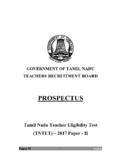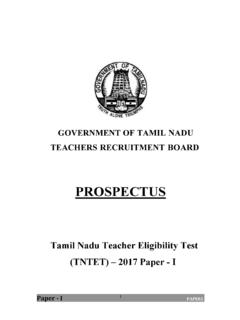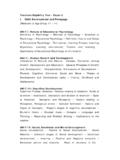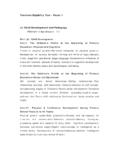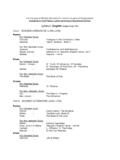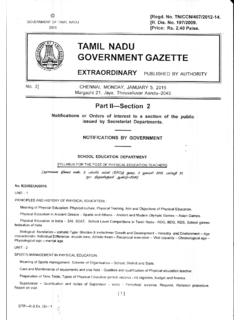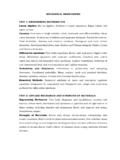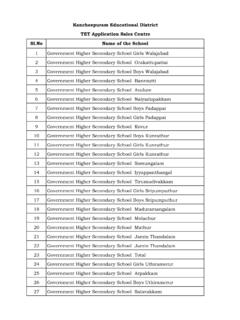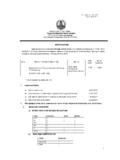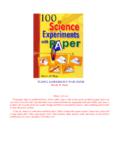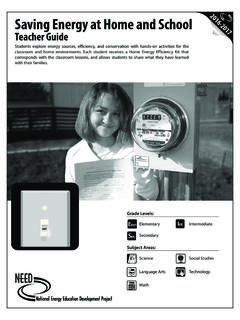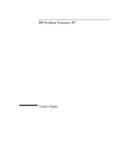Transcription of TET Paper 1 English - Teachers Recruitment Board
1 (iii) Language II English (Classes i to V). Class I. 1. Listening Mode of Competency Content Evaluation Transaction Listening to jingles / Jingles / Teacher sings or Listen to the tune and Nursery rhymes Nursery plays sing the rhyme. rhymes the recorded Respond with the next Understanding key cassettes word or sentence when words in the rhymes the teacher pauses while singing the rhyme. Perform actions related to the rhyme. Listening to short, Simple short Teacher narrates Do actions related to familiar stories or familiar Stories, or folktales. the story / folktale folktales stories Children listen and Reproduce any respond environmental sounds Understanding the (Eg. wind blowing, crow main point of short cawing) occurring in the stories told in story. English Listen and respond to simple questions related to the story or folktale.
2 Can follow simple Simple class Teacher gives Listen to instructions instructions given in room instructions during and respond English instructions the appropriately during the course of the day course of the day. and children respond. '. Come here, Sit down '. Teacher conducts games/activities to make use of simple commands/requests/. instructions. Understanding and Time - specific Teacher creates Listen to the greetings responding to greetings greetings Good different situations and appropriately. morning/ for respond with the correct afternoon/ the children to listen form of greeting. evening' and respond to greetings Practice greetings through Teacher displays rhymes and action charts songs / pictures depicting morning, evening, noon and relates them to the correct form of greeting based on time.
3 Listening to sounds Children discriminate in selected words, and the sounds and respond discriminating them. appropriately. Clap your hands every time you hear a word beginning with /b/ - sun, cap, ball, banana, ship, boat . Relating sound and Children listen and Circle pictures letter. discriminate the beginning or ending sounds with a particular letter. that the letters make. Do the two pictures rhyme?' Say yes' or no'. Listening and Simple Teacher asks Respond appropriately responding questions What simple to appropriately to simple & Where questions during the questions. questions course of the day and What is your name? the children What is this? respond. Where is the bag? 2. Speaking Singing jingles / Jingles / Children sing along Sing the jingles /. rhymes rhymes with nursery rhymes the teacher or suggested by the cassettes teacher or their and reproduce favourite one.
4 Familiar jingles/ nursery rhymes Expressing needs and Needs and likes Teacher Express needs / likes /. likes encourages dislikes /feelings students to express spontaneously in needs and likes / response to questions. dislikes / feelings and acknowledges them. Asking permission Can I ..' Teacher Use 'Can I ..? /. 'May I .?' encourages children to use questions in relevant situations. Respond to Words, phrases Teacher asks Respond to questions questions and simple appropriately. sentences questions during the course of the day and children respond. Speaking using a Functional Teacher provides Answer questions combination of grammar: opportunities using grammatical forms adjectives, through phrases / sentences. articles, activities and Where is the book? . prepositions informal On the table.
5 Conversation for children to speak using a combination of grammatical forms. 3. Reading Recognizing and Letters of the Teacher presents Circle the letter e' in naming letters alphabet visual these and kinesthetic words: apple, ant, am activities cat, for children to cap, bat recognize and name letters. Letter sound Sounds of the Teacher shows correspondence alphabet cards with letters of the alphabet and articulates the sound. Children repeat after the teacher. Reading Teacher provides Read words words/sentences Words/Sentences opportunities for Read simple sentences children to read Choose the correct using flash cards. word Children label things for each picture. around the class room. Picture Reading Simple and Teacher shows a Children use pictures class room. Composite variety of pictures as an pictures and asks the aid for reading.
6 Students to name the words they know Summative already. Read and match words with relevant pictures. Responding to various Books, flash Teacher makes Browse/read the types of reading cards, available different different material. labels, charts, types of reading reading materials etc materials and available encourages the in the class room. children to use them. Reading for fun Reading Teacher facilitates Look at the pictures Graded children to look at and readers, pictures / read enjoy them. colourful books. Read books for picture books pleasure. 4. Writing Pre writing activities Mazes, Joining Teacher presents Join dots to create dotted lines and variety of materials shapes / pictures. writing patterns such as worksheets, Colour a variety of sand box, sand pictures. Paper , Copy basic strokes stencils, etc for and children to develop patterns.
7 Fine motor skills for writing. Write Letters of the Teacher presents a Trace on dotted Upper case and lower alphabet In variety of materials letters. case letters each such as worksheets, Copy and write letters. unit sand box, sand Recall and write Paper , letters. stencils, etc for children to write upper case and lower case letters. Write with Words Children write Copy words and Spacing of words, /Sentences leaving sentences. alignment of words in a space in between Trace over dotted sentence (Mechanics of words words. writing) and write on a line. Recall spelling Words ( high Teacher presents a Arrange jumbled frequency words, variety of writing letters to phonetic words exercises and word make words. and building activities Look at the picture content words) such and fill in the blanks as word grids, with the correct letter.
8 Jumbled Write the first/last letters, fill ups, letter for each picture. dictation to develop spelling skills. Writing Common, Teacher presents Arrange word cards to words/simple familiar activities such as make sentences. sentences words/sentences jumbled words, fill Write one's name. ups, Write the words for to write words and the given pictures. sentences. Fill in the blanks with the correct word. Put the words in correct order and make a sentence. 5. Vocabulary Point out parts of Head, hands, Teacher uses Sing songs pointing to body. ears, mouth, action and naming parts of the neck, eyes, songs, pictures, body: Head, shoulders, nose, legs, toes stories and activities knees and and fingers. for children to point toes .'. and name the body parts. Stating the relationship Father, mother, Teacher uses of brother, sister, songs, family members.
9 Grandfather, conversations, grandmother stories, pictures and worksheets to use home relationships. Writing the Names of Common fruits, Teacher uses fruits, flowers, flowers, songs, vegetables, animals, vegetables, pictures, stories, real vehicles, common animals, objects and activities objects and other things vehicles, sun, for around us. moon, stars, etc. children to identify and name them. Naming Colours Red, green, Teacher uses Painting and colouring yellow and white songs, activities. Circle, triangle, pictures, children to sphere, rectangle identify and name and square the colours. Stating number 1 to 10 Teacher guides the Finger counting and names children in reading songs. and writing number Summative and number names Count and say how through activities many like tracing on dotted lines, matching number to number names, etc Distinguish singular Singular and Teacher uses from plural names.
10 Plural 's' classroom objects, pictures, worksheets, charts, children, etc for the children to name one and more than one. Referring to Opposites Common words Teacher uses Use words such as big, such as big, classroom objects, small, clean, dirty to small, tall, short, pictures, stories, compare, contrast and up, down, etc. songs, worksheets, describe in a charts, etc for the conversation children to compare, contrast and describe them. Using Action words Common Teacher uses Can you hop like a actions such as songs, frog? Yes, I can. read, jump, eat, pictures and other (Children walk, play etc activities for children hop.). to identify and name Can you crawl like a different actions. snake? Yes, I can. (Children crawl.). Play games. Look at the picture. What are they doing? Naming Occupations Doctor, Teacher uses Role play.
